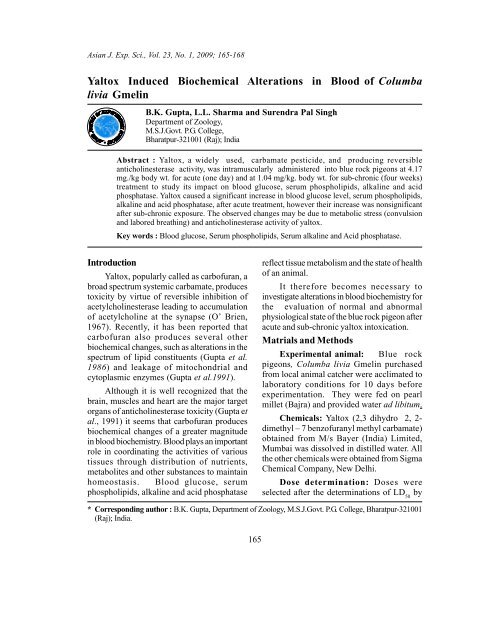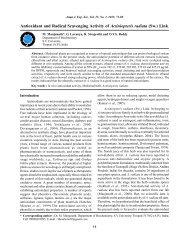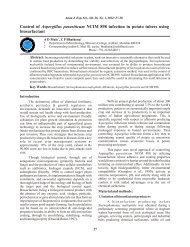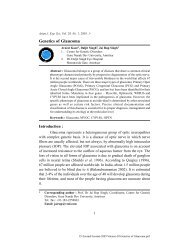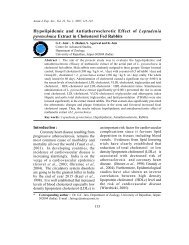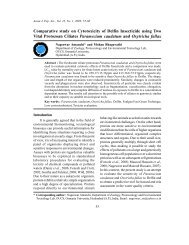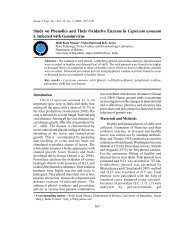Yaltox Induced Biochemical Alterations in Blood of Columba
Yaltox Induced Biochemical Alterations in Blood of Columba
Yaltox Induced Biochemical Alterations in Blood of Columba
You also want an ePaper? Increase the reach of your titles
YUMPU automatically turns print PDFs into web optimized ePapers that Google loves.
Asian J. Exp. Sci., Vol. 23, No. 1, 2009; 165-168<br />
<strong>Yaltox</strong> <strong>Induced</strong> <strong>Biochemical</strong> <strong>Alterations</strong> <strong>in</strong> <strong>Blood</strong> <strong>of</strong> <strong>Columba</strong><br />
livia Gmel<strong>in</strong><br />
Introduction<br />
B.K. Gupta, L.L. Sharma and Surendra Pal S<strong>in</strong>gh<br />
Department <strong>of</strong> Zoology,<br />
M.S.J.Govt. P.G. College,<br />
Bharatpur-321001 (Raj); India<br />
Abstract : <strong>Yaltox</strong>, a widely used, carbamate pesticide, and produc<strong>in</strong>g reversible<br />
antichol<strong>in</strong>esterase activity, was <strong>in</strong>tramuscularly adm<strong>in</strong>istered <strong>in</strong>to blue rock pigeons at 4.17<br />
mg./kg body wt. for acute (one day) and at 1.04 mg/kg. body wt. for sub-chronic (four weeks)<br />
treatment to study its impact on blood glucose, serum phospholipids, alkal<strong>in</strong>e and acid<br />
phosphatase. <strong>Yaltox</strong> caused a significant <strong>in</strong>crease <strong>in</strong> blood glucose level, serum phospholipids,<br />
alkal<strong>in</strong>e and acid phosphatase, after acute treatment, however their <strong>in</strong>crease was nonsignificant<br />
after sub-chronic exposure. The observed changes may be due to metabolic stress (convulsion<br />
and labored breath<strong>in</strong>g) and antichol<strong>in</strong>esterase activity <strong>of</strong> yaltox.<br />
Key words : <strong>Blood</strong> glucose, Serum phospholipids, Serum alkal<strong>in</strong>e and Acid phosphatase.<br />
<strong>Yaltox</strong>, popularly called as carb<strong>of</strong>uran, a<br />
broad spectrum systemic carbamate, produces<br />
toxicity by virtue <strong>of</strong> reversible <strong>in</strong>hibition <strong>of</strong><br />
acetylchol<strong>in</strong>esterase lead<strong>in</strong>g to accumulation<br />
<strong>of</strong> acetylchol<strong>in</strong>e at the synapse (O’ Brien,<br />
1967). Recently, it has been reported that<br />
carb<strong>of</strong>uran also produces several other<br />
biochemical changes, such as alterations <strong>in</strong> the<br />
spectrum <strong>of</strong> lipid constituents (Gupta et al.<br />
1986) and leakage <strong>of</strong> mitochondrial and<br />
cytoplasmic enzymes (Gupta et al.1991).<br />
Although it is well recognized that the<br />
bra<strong>in</strong>, muscles and heart are the major target<br />
organs <strong>of</strong> antichol<strong>in</strong>esterase toxicity (Gupta et<br />
al., 1991) it seems that carb<strong>of</strong>uran produces<br />
biochemical changes <strong>of</strong> a greater magnitude<br />
<strong>in</strong> blood biochemistry. <strong>Blood</strong> plays an important<br />
role <strong>in</strong> coord<strong>in</strong>at<strong>in</strong>g the activities <strong>of</strong> various<br />
tissues through distribution <strong>of</strong> nutrients,<br />
metabolites and other substances to ma<strong>in</strong>ta<strong>in</strong><br />
homeostasis. <strong>Blood</strong> glucose, serum<br />
phospholipids, alkal<strong>in</strong>e and acid phosphatase<br />
165<br />
reflect tissue metabolism and the state <strong>of</strong> health<br />
<strong>of</strong> an animal.<br />
It therefore becomes necessary to<br />
<strong>in</strong>vestigate alterations <strong>in</strong> blood biochemistry for<br />
the evaluation <strong>of</strong> normal and abnormal<br />
physiological state <strong>of</strong> the blue rock pigeon after<br />
acute and sub-chronic yaltox <strong>in</strong>toxication.<br />
Matrials and Methods<br />
Experimental animal: Blue rock<br />
pigeons, <strong>Columba</strong> livia Gmel<strong>in</strong> purchased<br />
from local animal catcher were acclimated to<br />
laboratory conditions for 10 days before<br />
experimentation. They were fed on pearl<br />
millet (Bajra) and provided water ad libitum.<br />
Chemicals: <strong>Yaltox</strong> (2,3 dihydro 2, 2dimethyl<br />
– 7 benz<strong>of</strong>uranyl methyl carbamate)<br />
obta<strong>in</strong>ed from M/s Bayer (India) Limited,<br />
Mumbai was dissolved <strong>in</strong> distilled water. All<br />
the other chemicals were obta<strong>in</strong>ed from Sigma<br />
Chemical Company, New Delhi.<br />
Dose determ<strong>in</strong>ation: Doses were<br />
selected after the determ<strong>in</strong>ations <strong>of</strong> LD by 50<br />
* Correspond<strong>in</strong>g author : B.K. Gupta, Department <strong>of</strong> Zoology, M.S.J.Govt. P.G. College, Bharatpur-321001<br />
(Raj); India.
Gupta B.K. et al. (2009) Asian J. Exp. Sci., 23(1), 165-168<br />
the log probit analysis method (F<strong>in</strong>ney, 1971).<br />
The sub lethal doses were selected for<br />
experimentation.<br />
Experimental protocol: Forty healthy<br />
pigeons irrespective <strong>of</strong> sex were selected for<br />
experimentation. The pigeons were weighed<br />
and divided randomly <strong>in</strong>to four sets- one acute<br />
<strong>of</strong> 4 pigeons, one sub-chronic <strong>of</strong> 16 pigeons,<br />
and two control <strong>of</strong> 4 and 16 pigeons for acute<br />
and sub-chronic treatments respectively. The<br />
experimental groups were given <strong>in</strong>tramuscular<br />
<strong>in</strong>jection <strong>of</strong> yaltox suspension <strong>in</strong> doses <strong>of</strong> 4.17<br />
mg/kg body weight and 1.04 mg/kg body wt.<br />
for acute and sub-chronic treatments<br />
respectively, Sixteen pigeons <strong>of</strong> sub-chronic<br />
group were given four fractionated sub-lethal<br />
doses on 1st , 7th , 14th and 21st day. The controls<br />
were given vehicle treatment only us<strong>in</strong>g a<br />
similar amount <strong>of</strong> diluent through <strong>in</strong>tramuscular<br />
<strong>in</strong>jection.<br />
<strong>Blood</strong> samples: The pigeons were<br />
euthanized and the blood was drawn by ex–<br />
sanguivation from heart <strong>in</strong>to the oxalatefluoride<br />
bulb for glucose estimation and test<br />
tubes without anticoagulant for serum<br />
separation. Serum was separated by<br />
centrifugation at 300-400 rpm for 20 m<strong>in</strong>utes.<br />
<strong>Biochemical</strong> estimation: Level <strong>of</strong> blood<br />
glucose, serum phospholipids, alkal<strong>in</strong>e and acids<br />
phosphatase were estimated by the method<br />
given by Somogyi (1952), K<strong>in</strong>d and K<strong>in</strong>g (1954),<br />
K<strong>in</strong>g and Jagatheesan (1959) respectively.<br />
Analysis <strong>of</strong> data: Data were subjected<br />
to statistical evaluation us<strong>in</strong>g standard statistical<br />
procedures students t-test.<br />
Results and Discussion<br />
The follow<strong>in</strong>g cl<strong>in</strong>ical symptoms and blood<br />
biochemical changes <strong>in</strong> acutely and subchronically<br />
yaltox treated pigeons were<br />
recorded as compared to controls.<br />
Cl<strong>in</strong>ical symptoms: On <strong>in</strong>troduction <strong>of</strong><br />
an acute dose <strong>of</strong> yaltox pigeons exhibited<br />
166<br />
hypersalivation and tremors with<strong>in</strong> 5-7 m<strong>in</strong>utes.<br />
The convulsions, diahrroea labored breath<strong>in</strong>g<br />
and leg weaknesses with high severity were<br />
evident with<strong>in</strong> 15-30 m<strong>in</strong>utes and lasted about<br />
three hours. However <strong>in</strong> sub-chronically<br />
treated pigeons the toxicity manifestations were<br />
<strong>of</strong> mild severity and lasted about one hour as<br />
has also been reported by Sar<strong>in</strong> and Gill (2002).<br />
<strong>Blood</strong> biochemical changes: The blood<br />
biochemical changes are depicted <strong>in</strong> Table- 1.<br />
<strong>Blood</strong> glucose level rises significantly after<br />
acute and sub-chronic (7 days) exposure<br />
followed by non-significant <strong>in</strong>crease <strong>in</strong><br />
subsequent sub-chronic treatments.<br />
An <strong>in</strong>crease <strong>in</strong> blood glucose level might<br />
be due to <strong>in</strong>terference <strong>in</strong> the cellular blood<br />
supply and enhanced fuel and energy<br />
requirement <strong>of</strong> the tissue as a result <strong>of</strong><br />
convulsion and pulmonary stress caused by<br />
yaltox. The <strong>in</strong>tense muscle activity and<br />
pulmonary stress so <strong>in</strong>duced may stimulate the<br />
conversion <strong>of</strong> hepatic glycogen (Guyton and<br />
Hall, 2001) <strong>in</strong>to blood glucose to compensate<br />
the high energy consumption due to the<br />
stimulatory effect <strong>of</strong> yaltox, as has also been<br />
reported by Gupta and Saxena (1996), Gupta<br />
(1997) and Saxena et al (1998).<br />
The normal value <strong>of</strong> blood glucose after<br />
sub-chronic (day 21 to 28) treatment may be<br />
accounted on the basis <strong>of</strong> a clearance <strong>of</strong><br />
glucose from the blood and transformation <strong>of</strong><br />
this precursor <strong>in</strong>to glycogen <strong>in</strong> liver which may<br />
be due to either lower toxicity stress or the<br />
very less residual effect <strong>of</strong> pesticide <strong>in</strong> question,<br />
the f<strong>in</strong>d<strong>in</strong>gs are <strong>in</strong> agreement to Gupta (1997)<br />
and Sar<strong>in</strong> and Gill (1999).<br />
A significant elevation <strong>in</strong> the level <strong>of</strong> serum<br />
phospholipids after one-day acute treatment<br />
and a non-significant <strong>in</strong>crease after all the subchronic<br />
<strong>in</strong>toxication <strong>of</strong> yaltox <strong>in</strong> pigeons has<br />
been observed. In the present study the<br />
<strong>in</strong>crease <strong>in</strong> serum phospholipids along with the<br />
<strong>in</strong>creas<strong>in</strong>g blood glucose level and acid and
Treatment<br />
and Dose<br />
Acute (4.17<br />
mg/kg.)<br />
Sub-chronic<br />
1.04 mg/kg<br />
alkal<strong>in</strong>e phosphatase is evident. These f<strong>in</strong>d<strong>in</strong>gs<br />
are <strong>in</strong> accordance to Fayez and Kilgore (1992),<br />
Gupta (1997) and Ender (2006).<br />
Activity <strong>of</strong> serum alkal<strong>in</strong>e phosphatase<br />
<strong>in</strong>creases significantly after acute and subchronic<br />
(up to 14 days) treatments with a nonsignificant<br />
elevation <strong>in</strong> the successive subchronic<br />
exposures.<br />
The <strong>in</strong>crease <strong>in</strong> the level <strong>of</strong> serum alkal<strong>in</strong>e<br />
phosphatase may be attributed to the<br />
pulmonary stress and susta<strong>in</strong>ed muscle<br />
fasciculations that may lead to oxygen<br />
<strong>in</strong>sufficiency caus<strong>in</strong>g impairment <strong>in</strong> the cell<br />
membrane permeability <strong>of</strong> hepatocyte (Gupta<br />
et al. 1991). S<strong>in</strong>ce alkal<strong>in</strong>e phosphatase is a<br />
membrane bound enzyme, any change <strong>in</strong><br />
membrane permeability results <strong>in</strong> leakage <strong>of</strong><br />
enzyme <strong>in</strong>to the blood caus<strong>in</strong>g an <strong>in</strong>crease <strong>in</strong><br />
its level.The f<strong>in</strong>d<strong>in</strong>g ga<strong>in</strong> support by Ceron et<br />
al. (1995), Saxena and Gupta (1997) and Gupta<br />
<strong>Yaltox</strong> <strong>Induced</strong> <strong>Biochemical</strong> <strong>Alterations</strong> <strong>in</strong> <strong>Blood</strong> <strong>of</strong> <strong>Columba</strong> livia Gmel<strong>in</strong><br />
Table 1 : <strong>Blood</strong> <strong>Biochemical</strong> changes after yaltox <strong>in</strong>toxication <strong>in</strong> <strong>Columba</strong> livia Gmel<strong>in</strong><br />
Days <strong>Blood</strong> glucose Serum Serum alkal<strong>in</strong>e Serum acid<br />
(mg/100 ml) phospholipids phosphatase phosphates<br />
Mean±S.E Mean±S.E<br />
Mean±S.E Mean±S.E<br />
C T C T C T C T<br />
1 125.34 ± 148.04 ± 2.45 ± 3.189 ± 12.497 ± 20.681 ± 1.666 ± 2.039 ±<br />
3.95 4.16 0.167 0.147 1.582 1.263 3.77 0.343<br />
A A N.S<br />
7 142.78 ± 158.06 ± 2.417 ± 2.407 ± 10.452 ± 16.050 ± 2.878 ± 3.446 ±<br />
3.14 3.006 C 0.121 0.110 0.689 0.593 0.072 0.225<br />
N.S A N.S<br />
14 145.79 ± 162.09 ± 2.592 ± 2.680 ± 9.807 ± 17.082 ± 2.812 ± 1.978 ±<br />
3.389 6.114 0.80 0.071 0.569 1.296 0.418 0.234<br />
N.S N.S A N.S<br />
21 147.52 ± 149.45 ± 2.857 ± 2.807 ± 11.762 ± 15.277 ± 2.083 ± 2.499 ±<br />
2.455 3.592 0.026 0.020 0.637 1.116 0.447 0.2<br />
N.S N.S N.S N.S<br />
28 156.63 157.74+5. 2.815 2.827 20.765 23.550 6.562 7.125 ±<br />
+6.317 065 +0.057 +0.049 +0.637 +0.853 +0.474 0.37<br />
N.S N.S B N.S<br />
C= Control, T= Treated, N.S. = Non significant, A= P< .01, B= P
Gupta B.K. et al. (2009) Asian J. Exp. Sci., 23(1), 165-168<br />
References<br />
Ceron J., Panizo C.O. and Montes A. (1995):<br />
Toxicological effects. In rabbit <strong>in</strong>duced by<br />
endosulfan, l<strong>in</strong>dane and Methyparathion<br />
represent<strong>in</strong>g agricultural by products<br />
contam<strong>in</strong>ation. Bull. Environ, Contam, Toxicol.<br />
54, 258-265.<br />
EnderY.C. (2006) : Effects <strong>of</strong> dichlorvos on lipid<br />
peroxidation <strong>in</strong> mice on subacute and<br />
subchronic period. Pesticide Biochem. and<br />
Physiology. 86 (2), 106 – 109.<br />
Fayez V. and Kilgore W.W. (1992): Acute Toxic effect<br />
<strong>of</strong> oxamyl <strong>in</strong> the rat. Fundam, Appl. Toxiciol,<br />
18, 155-159.<br />
F<strong>in</strong>ney W.J. (1971): Probit analysis, Cambridge<br />
University Press, pp.41-303.<br />
Gupta B.K. and Saxena P.N. (1996): Effect <strong>of</strong> yaltox<br />
on blood and liver carbohydrats <strong>in</strong> <strong>Columba</strong><br />
livia Gmel<strong>in</strong>, proced<strong>in</strong>g. 66th Anu. Session<br />
National Acad. Sca<strong>in</strong>dia<br />
Gupta B.K. (1997): Toxicological evaluation <strong>of</strong> yaltox<br />
<strong>in</strong> blue rock pigeon, <strong>Columba</strong> livia Gmel<strong>in</strong>, an<br />
assessment based on behavioral changes,<br />
blood and liver biochemistry, Ph.D.thesis. Dr.<br />
B.R. Ambedkar University Agra (U.P.)<br />
Gupta M., Mukherjee S., Gupta S.D., Dolui A.K.,<br />
Dey S.N. and Roy D.K. (1986): Changes <strong>of</strong> lipid<br />
spectrum <strong>in</strong> different tissues <strong>of</strong> furadan teated<br />
mice. Toxicology, 38, 69-70<br />
Gupta R.C., Goad J.Y. and Kadal W.L. (1991):<br />
Carb<strong>of</strong>uram- <strong>in</strong>duced alteration (<strong>in</strong> vivo) <strong>in</strong> highenergy<br />
phosphates, creat<strong>in</strong>e k<strong>in</strong>ase (CK) and<br />
CK isoenzymes, Arch. Toxicol., 65, 304-310.<br />
Guyton A.C. and Hall J.E. (2001): Cardiac<br />
Arrythimias and their Electrocardia graphic<br />
<strong>in</strong>terprelation <strong>in</strong>: T.B. <strong>of</strong> Medical Physiology,<br />
First Indian edition, Harcourt Asia PTE Ltd.pp.<br />
149-158.<br />
K<strong>in</strong>d D.R.N. and K<strong>in</strong>g E.J. (1954): Estimation <strong>of</strong><br />
plasma phosphatase by determ<strong>in</strong>aion <strong>of</strong><br />
168<br />
hydrolyzed phenol with am<strong>in</strong>oantipyr<strong>in</strong>e. J.<br />
Cl<strong>in</strong>. Path., 7, 322-326.<br />
K<strong>in</strong>g E.J. and Jagatheesan K.A. (1959).Estimation<br />
<strong>of</strong> plasma acid phosphatase. J.Cl<strong>in</strong>.Path., 12,<br />
85-89.<br />
O’ Brien R.D. (1967) Insecticides: action and<br />
metabolism, Acade New York. pp. 83-107.<br />
Sar<strong>in</strong> S. and Gill K.D. (2002): <strong>Biochemical</strong> and<br />
Behavioral deficits <strong>in</strong> adult rat follow<strong>in</strong>g chronic<br />
dichlorvos exposure. Archiv. <strong>of</strong> Toxicology,<br />
19, 222 –225.<br />
Sar<strong>in</strong> S and Gill K.D.(1999) : Dichlorvos <strong>in</strong>duced<br />
alteration <strong>in</strong> glucose homoeostasis : Possible<br />
implication on the state <strong>of</strong> neuronal function<br />
<strong>in</strong> rat. Molecular and Cellular Biochemistry.<br />
199, 87-92.<br />
Saxena P.N., Gupta B.K. and Sharma L.L. (1998):<br />
Impact <strong>of</strong> phenyl substituted N-Methyl<br />
carbamate on liver biochemistry <strong>of</strong> <strong>Columba</strong><br />
livia Gmel<strong>in</strong>. Proc. Acad. Environ. Biol., 7(1),<br />
51-56.<br />
Saxena P.N. and Gupta Y.K. (1997): Effect <strong>of</strong><br />
mexacarbate on certa<strong>in</strong> liver biochemical<br />
parameters <strong>of</strong> Passer domesticus (L<strong>in</strong>n).<br />
J.Environ. Biol., 18 (3), 266-268.<br />
Somogyi M. (1952): Nelson – Somogyi method <strong>of</strong><br />
estimation <strong>of</strong> blood glucose. J. Biol.Chem., 195,<br />
19.<br />
Tomar M.S., Dhanotiya R.S., Shilaskar D.V. and<br />
Dixit N.K. (1995): Effect <strong>of</strong> malathion on enzyme<br />
<strong>of</strong> goat liver and serum. J. Environ. Biol., 16(2),<br />
151-155.


